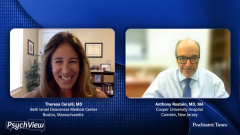
Adult ADHD Treatment Failure
Experts in attention-deficit/hyperactivity disorder (ADHD) discuss how to determine treatment failure in adults and the benefit of different dosing strategies for therapeutic options.
Episodes in this series

Theresa Cerulli, MD: How do you determine treatment failures in your adults with ADHD [attention-deficit/hyperactivity disorder]? When are you ready to abort and say this is not working?
Anthony Rostain, MD, MA: Right. First of all, it is recommended that you use some scale or some measure of where your goals are and how close you are to getting them. If you’re using ASRS [Adult ADHD Self-Report Scale] or some other rating scale, and you don’t see improvement when you’ve incrementally gone up; let’s say we’re talking about stimulants for the time being. If you’ve gone up to what you believe is the highest safe dose and the patient’s not getting anywhere, remaining symptomatic or partially symptomatic, then I begin to think about either we have to switch to a different medication. Say if they’re on 1 stimulant and it’s just not getting them anywhere, you might try the other stimulant class, or the patient might benefit from augmentation with a nonstimulant. I do think we should follow the FDA guidelines where possible.
But oftentimes, patients may need a slightly higher daily dose. As long as they’re getting a benefit that’s impacting functioning, they don’t have to go right down to 0 symptoms, but more within the realm of, “I can function now.” I also consider a treatment failure one in which patients are not able to maintain the regimen because of adverse effects. You have to play around with both changing the timing of the medication and maybe changing the preparation and/or augmenting with, say, a nonstimulant as well as a stimulant.
Theresa Cerulli, MD: I refer to those patients as those who have a love-hate relationship with their medication. They know it helps them, but the jaw tightness they get, or….
Anthony Rostain, MD, MA: I agree.
Theresa Cerulli, MD: They need better options to be able to sustain taking the drug if it’s going to cause them adverse effects.
Anthony Rostain, MD, MA: It’s important to ask that question right off the bat, “What’s getting in the way of you taking the medication? What adverse effects are really bothering you now, so that we can address those?” Because if they hate taking it, in the long run, it’s going to be tough for them to remain long term on the medication.
Theresa Cerulli, MD: Which gets me back to the discussion on prodrugs, because I remember when lisdexamfetamine first came out, and it was in the amphetamine family, yet those who were on mixed amphetamine salt extended-release preparations who I had switched to lisdexamfetamine, the pro-drug, said that it felt like it wasn’t even there, and that they weren’t sure they were taking it or if it was effective. It was such a difference in how it felt physiologically to the person that they questioned, are you trading efficacy? And I hadn’t really explained to my patients, “Wait, don’t quit on me. I’m not looking for that feeling physically. In fact, I prefer you not to feel that you’re medicated. I would rather know you’re getting the cognitive benefit and not feel the drug kick in.”
Anthony Rostain, MD, MA: Yes. They’ve gotten used to feeling the pop. And if the pop isn’t there, it’s not working. It’s really important to clarify the difference between that sense of the medication starting up and it being there without you noticing. For some people, it’s a great benefit to not have that feeling of it kicking in, but for those who look for it, yes, they’re going to feel like, “Hey, this isn’t doing much.”
Transcript Edited for Clarity
Newsletter
Receive trusted psychiatric news, expert analysis, and clinical insights — subscribe today to support your practice and your patients.

















